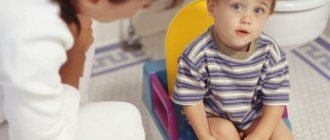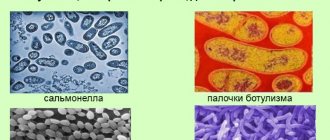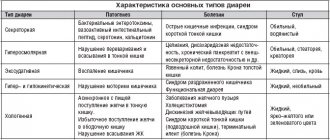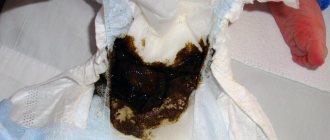Gastrointestinal disorders are an extremely common phenomenon that can be accompanied by various types of painful sensations.
As a rule, such conditions sharply reduce the quality of life.
The manifestation of symptoms that may be associated with the development of a pathological process in the child’s body always causes anxiety on the part of the parents.
Especially when unpleasant signs occur in infants.
The baby cannot explain whether something hurts, so new mothers and fathers, as a rule, begin to panic.
In order to avoid such situations, it is important to know: is diarrhea in a five-month-old baby normal or pathological, what are the causes and, of course, what to do?
When is diarrhea in a newborn baby normal?
Diarrhea is an unpleasant condition that absolutely every person has encountered at least once in their life. That is why it would seem that identifying diarrhea in a child is a simple task, but this is not entirely true.
In the first six months, it is quite difficult to detect diarrhea in a baby, especially if the child is completely breastfed, that is, receives the necessary nutrients through breast milk.
This is due to the fact that the baby’s stool in the first few months after birth has the form of a thin paste.
In this regard, new parents quite often mistake a child’s normal bowel movements for diarrhea. That is why it is important to know certain norm criteria.
- In a one-month-old baby, the process of defecation may occur after each feeding, since the gastrointestinal tract has not yet fully stabilized. Feces are liquid and bright yellow in color. In addition, mucous discharge and white streaks may be observed in the stool - a criterion for normality, since digestion is just returning to normal.
- In a 2-month-old child, defecation occurs much less frequently; the characteristics of the feces remain identical.
- At three to five months, the normal daily urge to defecate is once or twice. At the same time, the stool becomes different from diarrhea, since it becomes more homogeneous and the color darkens.
If everything in your baby matches the above factors, then there is no reason to worry. Since the baby’s body gradually gets used to new environmental conditions.
Please note that when artificial feeding is introduced, the stool darkens and becomes dense.
In this case, loose stools, that is, diarrhea, is most often a clinical sign of the development of a disease in the body.
Features of stool in children under one year old
Normal stool of children from birth to one year has a liquid consistency due to the characteristics of their nutrition and the structure of the enzyme system. Breastfed babies poop 5-6 times a day, their stool is yellow and has a homogeneous mushy state. The contents of the diaper of formula-fed or mixed-fed babies have a brownish-yellow tint, it is thicker, without any impurities. In the first months of life, the passage of liquid feces by a child is not diarrhea and does not require treatment in the absence of other unfavorable symptoms.
Even if acquaintances or friends claim that loose stools in an infant are diarrhea, there is no need to believe such misconceptions. Normal feces in infants are soft, mushy, and their consistency directly depends on the food consumed.
Breastfeeding without complementary foods does not contain solid particles, so thick stool from milk does not form. It becomes dense only after the mother begins to introduce complementary foods, giving the child fruits, vegetable purees, and soups.
Features of discharge by month:
- In the first hours or days of life, the baby's feces are black, dark green, dense, and odorless. Original stool is called meconium, its excretion indicates normal bowel function.
- During the first months of life, the baby poops loosely, his discharge has a bright yellow, brownish, golden hue, and a sour milky smell when breastfed. If the baby is fed formula, the stool becomes greenish in color and has an unpleasant odor. The appearance of white undigested lumps and a small amount of mucus is not a pathology.
- After 6 months, after the first complementary foods, the feces become thicker and darker in color. The baby can poop from 2 to 6-7 times a day, but weight gain should be within normal limits. Rare stool (once every 2-3 days) is not a pathology if the child feels well, looks healthy and cheerful.
Pediatricians recommend that mothers monitor not only the color and consistency, but also the volume of feces. Babies up to 4-5 months poop often, but little by little. Children after 7-8 months go to the potty “mostly” 1-2 times a day, sometimes less often.
You should be wary if the discharge becomes frequent, thin, acquires an unpleasant odor, or changes color to green or dark brown. If the baby has become whiny, is capricious, twitches his legs, take measures to eliminate the painful symptoms.
Diarrhea is a clinical sign of the disease
Identifying situations where diarrhea indicates disturbances in the digestive system of a child under six months is not easy, but possible. For this, it is important and you need to know the accompanying symptoms.
- The stool contains: bloody streaks, an increased amount of mucus, purulent discharge, pieces of undigested food by the baby.
- The diarrhea is extremely watery, the urge to defecate exceeds the norm, that is, more than 8 per day.
- Baby feces have a sharp, specific odor and change in color to green or brown.
- Around the anus, hives, itching, redness, intense rashes and inflammatory processes appear.
Most often, diarrhea is acute and can go away on its own 24-48 hours after the onset.
But it should be noted that modern pediatricians identify a number of clinical signs when contacting a specialist is mandatory.
- Intense, sharp pain, while the child tries to press his legs to his stomach.
- Loss of body weight.
- General malaise, the baby becomes lethargic and is often capricious.
- Psycho-emotional instability.
- The appearance of drowsiness, apathetic state, lethargy.
- Intense regurgitation.
- Attacks of nausea and vomiting.
If a child experiences diarrhea in the first few months of life, which is accompanied by the above symptoms, then you should immediately seek qualified medical help.
Possible reasons
If a child has diarrhea, then you first need to find out what factors provoke this condition. You can cure an unpleasant symptom by eliminating their effect on the child’s body. Experts name several of the most likely causes of loose stools in babies:
1. Food poisoning. Diarrhea in this case is associated with intoxication by fermentation and putrefaction products formed during the digestion of spoiled food. Diarrhea serves as a response of the body trying to get rid of toxic compounds as quickly as possible. In parallel with diarrhea, nausea and vomiting often develop during poisoning. Sometimes the body temperature rises, but its value does not exceed 37 degrees.
2. Helminthic infestation. Diarrhea in children is one of the signs of helminth infection. Parasites present in the intestines irritate the receptors of the mucous membranes, which leads to their active contraction. Due to increased gastrointestinal peristalsis, diarrhea develops. Other characteristic symptoms also indicate helminthiasis - skin rash, weight loss, chronic fatigue.
3. Intestinal infections. Diseases caused by viruses or bacteria are widespread in childhood. Their main symptoms are diarrhea and fever in the child, developing against the background of severe pain in the lower or central part of the abdomen.
4. Dysbacteriosis. If loose stools alternate with prolonged constipation, then intestinal microflora may be disrupted. This means that the balance has shifted towards pathogenic organisms and the gastrointestinal tract is not functioning properly. In this situation, children develop diarrhea without fever, but with bloating or flatulence.
5. Stress. Any strong psychological shock affects the baby’s health. This is explained by changes at the hormonal level, resulting in contractions of the smooth muscles lining the intestinal walls. Diarrhea caused by stress usually goes away on its own and does not require medication.
6. Lactase deficiency occurs in newborns and infants. The condition is associated with the absence in the body of tiny enzymes required to process sugars present in breast milk or artificial formula.
The variety of causes of diarrhea leads to several treatment regimens. Pediatricians choose medications taking into account the full clinical picture, laboratory test data and the patient’s age.
The main causes of diarrhea in a child
Today, pediatricians identify several main conditions against which an infant may develop diarrhea. These include:
- Imbalance of intestinal microflora;
- Taking strong medications, antibiotics;
- Allergic food reaction or intolerance to any product;
- Including complementary foods in the child’s diet;
- Stressful state, change in climate zone;
- The presence of pathogenic microorganisms in the body: intestinal infection, helminths;
- Errors in the menu, breastfeeding mothers;
- Acute diseases requiring surgical intervention;
- A natural reaction to teething.
So that young parents know the differences between these conditions and why it is important to seek help in a timely manner, it is worth considering the most common causes in more detail.
How many days can a child have diarrhea?
The duration of diarrhea is difficult to predict; the timing of cessation of diarrhea depends on the causes that caused it. Until contact with the irritant stops, the consistency, color of stool and normal frequency of bowel movements will not be restored.
Duration of diarrhea depending on the diagnosis and subject to timely treatment:
- intestinal infection of bacterial origin – from 5 to 14 days;
- rotavirus - the acute phase lasts 2-3 days, then recovery occurs;
- reaction to a drug - diarrhea goes away on its own within 24 hours after stopping the drug;
- food poisoning - depending on the toxic agent. With proper treatment, the situation normalizes within a few days.
Frequent soft, even liquid, mushy stools in a breastfed or adapted formula baby are normal. But only if the child does not show signs of anxiety, there are no additional symptoms, the little one develops normally and gains weight.
Disturbance of intestinal microflora
This condition usually occurs after taking antibiotics. In addition, dysbiosis can manifest itself in a one-month-old baby.
Since during this period of time a peculiar adjustment of the gastrointestinal tract occurs.
If diarrhea occurs as a result of drug treatment, the baby is prescribed probiotics and prebiotics.
The dosage and necessary medicine are selected by a specialist. In this case, most often they use Linex and Hilak Forte.
What to do if your one-month-old baby has diarrhea? Causes of its occurrence and methods of treatment
Any loving parents always worry about their baby if he gets sick. Diarrhea in one-month-old babies mainly occurs due to the characteristics of their intestines at this age. Moreover, if the disease is mild, it can be easily treated at home.
Intestines of a one-month-old baby
Infants often experience constipation and colic.
In the first month of his life, the baby is just beginning to adapt to the new world. In his mother's tummy, while still a fetus, he received nutrients in a different way.
True, during the development of the baby in the stomach and in the period after his birth, nutrition is closely related to the mother’s diet.
The intestines of infants are special and require a gentle attitude. Therefore, in order to avoid serious problems with the baby’s tummy, a nursing mother must adhere to a strict diet in the first three months of the child’s life. Children's intestines often cause concern among parents. This is due to the following ailments:
- Bloating
- Colic
- Constipation
- Diarrhea
- Stool color
A baby's intestines are longer than those of an adult. It rests on the mesentery. In premature babies, the location of the intestinal system is often atypical. Compared to the adult intestine, the children's intestine has a number of features:
- High sterility at birth
- High permeability of nutrients entering the blood
- High mobility
A baby is born with a completely sterile intestine. However, later it becomes populated by microbes. The number of microorganisms depends on the following factors:
- Feeding method
- The state of the microflora of the baby and mother
- The baby's use of various medications
If a child is breastfed, bifidobacteria appear in the intestines. With artificial feeding, lactobacilli predominate. With the introduction of complementary foods, E. coli appear.
Microbes such as saprophytes help the body in the process of digesting food, and also contribute to the release of B vitamins. However, such beneficial microbes have representatives that can harm the intestines when they multiply.
Disorders of microorganisms can lead to dysbacteriosis. The occurrence of such a disease is possible after intensive therapy and taking potent medications. In this case, doctors usually prescribe probiotics for children.
In the first days of life, the newborn empties a thick, dark brown mass. Subsequently, the stool may be green, then yellow with a porridge-like consistency. The intestines of a breastfed baby react sharply to the mother's nutrition.
Therefore, his stool may contain lumps, green impurities, etc. Foamy stools most often indicate that the baby did not finish the milk, thereby not waiting for the most nutritious “back”.
After the introduction of complementary foods, the baby's stool begins to become more and more similar to the stool of an adult.
Baby's nutrition in the first month
Proper nutrition for a baby is very important.
The first time after birth, the baby is weakened and needs to get used to a new way of life. His intestinal system especially needs adaptation.
Therefore, a mother needs to approach the issue of feeding her child with all responsibility. The baby eats what his mother eats when breastfeeding or dry formula.
In the first months of life, it is advisable for the baby to eat mother's milk. Indeed, unlike mixtures, it contains all the useful and nutrient substances that increase the child’s immunity. And if the mother has chosen a natural method of feeding, then she should pay close attention to her diet, especially in the first month of the baby’s life.
At first, the baby eats up to 30 ml of milk. At the same time, if the baby demands more, you should not refuse him. During the first month the baby is advised to feed on demand. The more often the mother puts the baby to the breast, the more milk she will produce.
The child’s intestines are just beginning to work, so it should not be “loaded” with heavy food. In the first month of breastfeeding, mothers should exclude the following foods from their diet:
- Cow's milk
- Fermented milk products more than 200 ml per day and containing a high percentage of fat content
- Fried, spicy, smoked food
- Pickles, jams
- Red berries and fruit juice made from them
- Legumes
- Vegetables (except boiled potatoes and carrots)
- Fruits and fruit juices
- Black tea and coffee
- Sweets
- Flour products (except crackers and stale bread)
Read: Diarrhea with blood in an adult: causes, treatment tactics
At the same time, no matter how strict a diet the mother is on, the baby’s intestines are vulnerable, which provokes colic. Such a disease is inevitable in almost every child. The stomach bothers the baby until about 3 months of age.
Colic can be relieved by special medications, gymnastics, abdominal massage and placing a warm diaper on the stomach. However, it is impossible to completely get rid of pain. Parents just need to be patient.
Causes of diarrhea in a child in the first month of life
It is necessary to monitor the general condition of the child.
The digestive system of a newborn is just beginning to mature, and so on up to a year. Therefore, the gastrointestinal tract of infants is considered vulnerable, which can lead to various changes in stool.
In the first month of life, the baby can have bowel movements up to 12 times a day. Normal stool for an infant up to 6 months has the following characteristics:
- Yellow
- Porridge-like consistency
- Uniformity
- Sourish smell
- Minor amount of impurities
According to most pediatric doctors, green and loose stools are not a reason to panic if the baby feels well. A one-month-old baby's flora begins to form, and therefore the slightest malfunction of the digestive system can provoke dysbacteriosis.
Diarrhea in a baby can occur due to disruption of the digestive system. Loose stools are normal for a newborn. Therefore, it is important to be able to distinguish between loose stools and diarrhea. Signs of diarrhea in a one-month-old baby:
- Bloating, rumbling
- Pain, cramps in the abdomen
- Increased frequency of bowel movements
- Copious watery stools or scanty stools with impurities
- Black, green color of stool
- Unpleasant smell
Causes of diarrhea in a baby:
- Overfeeding
- Consumption of low-quality products
- Allergy
- Eating foods that cause a laxative effect
- Taking antibiotics
- Consequence of intensive care
- Lactase deficiency
- Imbalance of microorganisms
In the absence of intestinal infections and fever, diarrhea does not pose a threat to the baby and is easily treated. It is necessary to call a doctor in the following cases:
- Poor weight gain or sudden weight loss
- Excessively foamy and watery discharge
- Temperature
- Nausea
- Vomit
- Profuse regurgitation
- Lethargy, drowsiness
- Stomach ache
Greenish stool may not necessarily be a sign of illness. This sign may indicate a decrease in milk fat content or a lack of hindmilk production.
If the child is bottle-fed, then the greenish color of the stool may indicate a high iron content in the formula.
Treatment of diarrhea in a one-month-old baby
If you have diarrhea, your baby should be given plenty of water.
No one is immune from various diseases, including defenseless children. A one-month-old baby has a vulnerable intestine, which can lead to digestive disorders.
An ailment such as diarrhea can be easily treated at home. True, there are times when the help of a doctor is necessary.
First of all, when diarrhea is detected, it is necessary to give the child something to drink, since during the process of diarrhea, fluid is taken from the body.
Despite the baby’s gastrointestinal disorders, he also needs to eat. Mom will need to review her daily menu and make adjustments. Perhaps the nursing mother ate foods that cause a “laxative” effect.
If the child is bottle-fed, then you need to switch to another formula. The disease can also be treated with medications, but strictly as prescribed by the doctor. It is not advisable to give a one-month-old baby medication, but sometimes it is necessary.
Mild diarrhea lasts 2-3 days in infants. In this case, the stool turns green. This is how the intestines react to the introduction of new products into the diet or the composition of the dry mixture. It is advisable for nursing mothers to keep a food diary and track the reaction of the stool to the foods she eats. In case of artificial feeding, you just need to replace the formula.
If a month-old baby feels great with diarrhea, then there is no need to do anything. You will need to see a doctor in the following cases:
- Loose stools with bloody discharge
- Green stool with mucus
- Diarrhea accompanied by fever
- The disease began after taking prescribed medications
Breastfed babies are at the least risk of intestinal diseases. However, much depends on the diet of the nursing mother. If a mother eats prohibited foods while breastfeeding, then the beneficial properties of her milk will not be able to cope with the problems of the child’s digestive system.
Therefore, the most important moment in the first months of a child’s life is his nutrition. The more competently it is compiled, the healthier the baby’s gastrointestinal tract will be.
Learn how to stop diarrhea in a child from the video:
Select it and press Ctrl+Enter to let us know.
Tell your friends! Share this article with your friends on your favorite social network using social buttons. Thank you!
Tweet
Telegram
Class
What's up
Source: https://PishheVarenie.com/ponos/kak-ostanovit-ponos-u-rebenka-1-mesyats/
What to do and how to treat diarrhea in a baby
When new or inexperienced parents show signs of illness, the main thing is not to panic. The first thing mom and dad can do is call an emergency doctor.
What can be done before help arrives is an important topic that will allow parents, before receiving qualified intervention, to help and to some extent improve the condition of the baby.
- Avoid dehydration by giving your child a bottle of water frequently;
- To control body temperature, if it rises above 38, you can give drugs based on paracetamol;
- Do not give your baby any medications or use alternative medicine methods;
- Regularly change infant personal hygiene products;
- Eliminate complementary foods for a while;
- It is imperative to treat children's skin after defecation in order to prevent irritation and the development of an inflammatory process.
Diarrhea in a child can develop for numerous reasons, so if there is no danger to the baby’s life, the doctor in most cases prescribes comprehensive treatment.
- The use of antibiotics in case of an intestinal infection;
- The use of probiotics to normalize or maintain the balance of intestinal microflora;
- Systematic intake of electrolytes that promote rapid restoration of the intestinal mucosa;
- Prescription of enterosorbents, that is, drugs that remove substances unnecessary to the body.
If abnormal development of the digestive system, malignant neoplasms, or symptoms of dehydration are suspected, the baby and mother are hospitalized.
How to treat diarrhea in infants?
If parents notice the following symptoms in their children along with diarrhea, they should immediately consult a doctor or call an ambulance:
- body temperature increased to 38 degrees;
- drowsiness;
- weakness;
- signs of dehydration;
- lack of urination;
- loss of appetite;
- vomiting reflex;
- blood in stool.
Before the ambulance team arrives, parents need to replenish the water-salt balance in the baby’s body as quickly as possible. For these purposes, you should use special products that are sold without a prescription in every pharmacy, for example, Gastrolit, Oralit, Regidron. It is advisable to have them in every home first aid kit, so that in an emergency you don’t have to waste time looking for them. Such electrolyte solutions should be diluted with water according to the instructions and given to babies every 5-10 minutes in very small portions. If it is not possible to purchase such a drug, you can prepare the solution yourself. To do this, dissolve 1/2 tsp in a liter of boiled and cooled water. soda, 1 tsp. salt and 1 tbsp. l sugar.
When treating diarrhea, the doctor will make prescriptions only after a comprehensive diagnosis. As soon as the cause of this condition is identified, the specialist will select a course of safe drug therapy.
It may include the following drugs:
- to bring down the temperature, Efferalgan, Calpol or Panadol are prescribed;
- To remove toxins from the body, adsorbents are prescribed to the baby, for example Diosmectide, Neosmectin or Smecta.
Until the child’s condition returns to normal, parents should limit his diet. It excludes foods that can cause repeated bouts of diarrhea, such as chicken broth, cow's milk, and juices.
Possible complications
Modern experts emphasize the need to get help if a child develops supposedly pathological diarrhea.
It should be noted that the further state of the baby’s health depends on the timeliness and complexity of the medical treatment received.
The negative consequences that can appear, it would seem, after “ordinary” diarrhea include:
- Chronic gastrointestinal disorders;
- Convulsive attacks;
- Severe dehydration;
- Fatal outcome;
- Complications of microflora disturbances: bronchospasms, disruptions in intestinal conduction, various dermatological reactions, bronchial asthma;
- Negative consequences of pathogenic bacteria: sepsis, forms of shock, disruptions in electrolyte levels, cerebral edema;
- Absence or incorrect treatment of dysentery: hemorrhages in the organs of the digestive system, iron deficiency, severe forms of pneumonia, otitis media, arthritis, chronic dysbacteriosis.
The above complications indicate the need for correct, timely and high-quality treatment. Otherwise, the consequences may be irreversible.
Symptoms of dehydration
One of the most dangerous negative consequences of lack or untimely therapy is the development of dehydration.
A similar phenomenon in the body of a small child has the effect of lowering blood pressure, lowering heart rate, and can also lead to shock.
Please note that if the volume of fluid necessary for life is not normalized in time, the baby may die.
Symptoms of dehydration:
- Pale skin, severe dryness;
- A sharp decrease in body weight;
- Scanty and infrequent urination;
- The appearance of intense dark circles under the eyes;
- Disappearance of tears, dry surface of lips and tongue;
- Severe lethargy, the baby is capricious a lot, moves very little.
If these symptoms occur, you can give the baby a saline solution, for example, Regidron, and give the baby something to drink every 15 minutes.
Diarrhea is a fairly common occurrence in a baby in the first few months. In addition, one of the normal characteristics for infants is loose stools.
But it is important to note that there is also a pathological form of diarrhea; in this case, diarrhea is a sign of the presence of a disease in the body.
That is why young parents need to know exactly when loose stools are normal and when they need to seek medical help.
Lack of or prolonged treatment can lead to negative complications and even death.
What should “normal” stool look like?
In the first months, infants have loose stools - this is the norm!
In the first months of life, all babies have loose stools. This is considered normal. You should not react to the advice of “well-wishers” who claim that the chair should be decorated. Perhaps such people simply don’t remember how it should be or don’t know anything, but want to seem knowledgeable on this issue.
A newborn baby cannot have formed feces; in this case, he simply would not be able to perform an act of defecation. The child cannot yet sit or stand and receives only liquid food, so he should only have loose stools. The body cannot form normal feces for an adult, because solid food particles do not enter and formed feces simply have nowhere to come from.
Therefore, parents should be calm about loose stools, which in adults is considered a deviation from the norm. There is nothing wrong with this for babies. But if the baby has hard feces, constipation will begin, which you will have to fight with your own means. After all, delayed bowel movements cause no less problems than diarrhea.
Parents need to monitor the consistency and color of stool; these indicators may change with age. Moreover, changes can occur every day. Such mobility of indicators is more common in breastfed children. Mom's diet will have a noticeable effect on the color of her stool. Therefore, even if an unfamiliar color appears, there is no need to panic; you must first analyze what the nursing woman ate. Standard indicators are given below.
An elevated temperature should alert you!
The first hours, days after birth. The color of stool is dark, closer to dark green. This is the so-called meconium - original feces. It must definitely leave the baby's body. If this does not happen, the medical staff must be informed. The absence of meconium discharge often indicates pathology. For example, about intestinal atresia.
The first months. The norm is loose stool, the color can vary from greenish to golden. All shades of brown are acceptable. A small amount of mucous discharge is also normal. The stool should have a characteristic odor, reminiscent of sour milk. An unpleasant odor develops if the baby is artificially fed or on a mixed type of diet. In this case, it is impossible to predict exactly what the smell will be.
After six months, significant changes in consistency occur. The stool thickens and becomes creamy. The color also varies. We accept green, brown and yellow. If the baby is bottle-fed, the color can be dark green or yellow-brown.











